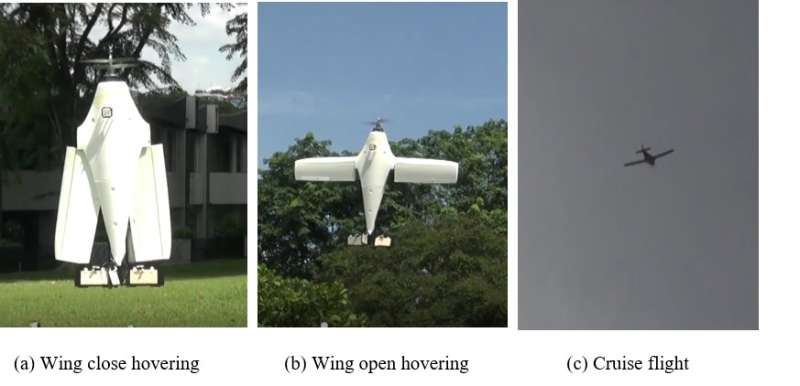A novel hybrid UAV that may change the way people operate drones

Two PhD students in National University of Singapore, Unmanned System Research Group spent four years developing novel hybrid unmanned aerial vehicles (UAVs). The U-Lion is a hybrid UAV that can take off and land vertically like helicopter UAVs, and transit to cruise flight like airplanes.
The wings can be fully retracted or expended to favor the stability in VTOL mode or provide efficient lift in cruise flight. U-Lion is also able to fly autonomously, and includes cruise flight and autonomous transitions. The technology brings practical hybrid UAVs one step closer. The research result has been published in Science China Information Sciences.
In recent decades, hybrid UAVs have attracted interest for potential applications in military and civilian operations, especially where there are severe constraints in the operating environment, for example, sea surveillance or forest mapping. The VTOL capability minimizes the requirements of take-off and landing facilities and cruise flying allows hybrid UAVs to perform long-range and duration tasks. The hybrid UAV is a hot research topic not only academically, but also commercially. Many companies have devoted resources in developing hybrid UAVs, such as Google Project Wing.
However, due to the structure differences between VTOL UAVs and fixed-wing UAVs, it is a huge challenge to combine the two functionalities into one single UAV. Previous attempts focused on either one of the flying modes, but did not optimize both. Besides, due to the high uncertain aerodynamic forces in the transition process, the transition process is difficult to automate.
To achieve optimal performance in both flying modes, U-Lion has tail-sitter configurations with reconfigurable wings and vectoring thrust. Different flying modes are used based on the mission requirements, and the wings adjust to achieve optimal performance. The ability allows U-Lion to fly much longer than typical VTOL UAVs, and it has greater maneuverability compared to normal fixed-wing UAVs. The advanced modelling and control algorithm overcomes the uncertainties in transition between configurations and achieves autonomous full-envelope flight.
"U-Lion, the autonomous hybrid UAV, has great potential in many applications," says Kangli. "The VTOL capability has widened its application environment and cruise capability enables it to performance long range tasks. The autonomous capability relieves the need for experienced pilots and further expands its applications."
More information: Kangli Wang et al, Autonomous reconfigurable hybrid tail-sitter UAV U-Lion, Science China Information Sciences (2017). DOI: 10.1007/s11432-016-9002-x
Provided by Science China Press




















